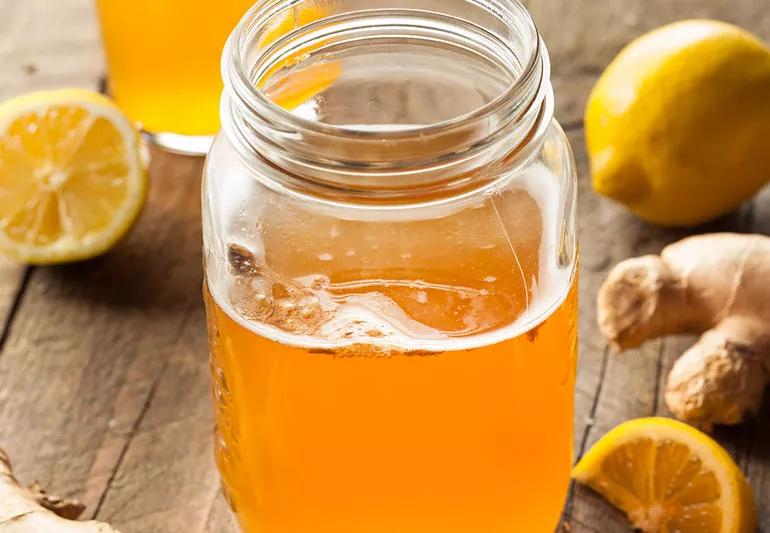A Comprehensive Guide
Kombucha, a fermented tea packed with probiotics, antioxidants, and enzymes, has become popular for its potential health benefits. This unique, effervescent drink is crafted by fermenting sweetened tea with a live culture known as a SCOBY (Symbiotic Culture of Bacteria and Yeast). Here’s a detailed guide to brewing kombucha at home, enabling you to make this healthy beverage in a few straightforward steps.
Ingredients and Equipment
Ingredients:
- Water – Use filtered or spring water for best results (tap water may contain chlorine, which can affect fermentation).
- Tea – Traditional black tea is recommended, but green tea is also suitable. Avoid flavored teas as they might interfere with fermentation.
- Sugar – Use regular granulated sugar. It feeds the SCOBY, with most being consumed during fermentation.
- Kombucha SCOBY – Essential for starting the fermentation process.
- Starter Tea – Use kombucha from a previous batch or store-bought to initiate fermentation.
Equipment:
- Large Glass Jar – For fermenting the tea.
- Cloth or Coffee Filter – To cover the jar and allow airflow.
- Rubber Band – To secure the cloth on the jar.
- Bottle with a Tight Lid – For bottling after fermentation.

Instructions
Step 1: Prepare the Sweetened Tea
- Boil Water: Heat 3-4 cups of water until boiling.
- Steep the Tea: Add 4-5 tea bags or 1 tablespoon of loose tea leaves to the hot water and steep for 5-10 minutes.
- Dissolve Sugar: Stir in 1 cup of sugar until dissolved.
- Cool the Tea: Remove tea bags or strain leaves, then add cold water to total about 1 gallon. Let cool to room temperature to avoid harming the SCOBY.
Step 2: Add the SCOBY and Starter Tea
- Pour the Sweetened Tea into the Jar: Ensure the tea is at room temperature.
- Add the Starter Tea: Pour in about 1 cup of kombucha from a previous batch or store-bought.
- Add the SCOBY: Carefully place the SCOBY on the tea’s surface.
Step 3: Cover and Ferment
- Cover the Jar: Use a cloth or coffee filter secured with a rubber band. This allows air passage while keeping out dust and insects.
- Ferment for 7-10 Days: Store the jar in a warm, dark place, such as a kitchen cabinet. Ferment for 7-10 days, depending on desired flavor strength. Longer fermentation results in a stronger taste.
Step 4: Taste and Bottle
- Taste Test: Use a straw to taste the kombucha. If it’s to your liking, it’s ready to bottle. If too sweet, ferment longer.
- Remove the SCOBY: Carefully take the SCOBY out and place it in a clean bowl. Reserve a cup of kombucha for your next starter batch.
- Bottle the Kombucha: Pour the kombucha into bottles, leaving some space at the top.
Step 5: Second Fermentation (Optional)
- Add Flavoring: Enhance each bottle with fruit, juice, or herbs for flavored kombucha.
- Seal and Ferment: Seal bottles tightly and let sit at room temperature for 2-3 days. This adds more fizz.
- Refrigerate: After the second fermentation, refrigerate the bottles to halt fermentation. Now, the kombucha is ready to enjoy!

SCOBY Storage and Maintenance
Store the SCOBY: If not making another batch immediately, place the SCOBY in a jar with enough kombucha to cover and store at room temperature.
Handling Tips: Rinse hands in vinegar before touching the SCOBY to prevent contamination.
Kombucha Tips
- Avoid Metal Utensils: Metal can affect the SCOBY. Use glass, wood, or plastic tools.
- Temperature Control: Kombucha ferments best between 68-85°F (20-30°C). Use a heating mat if your home is cool.
- Flavor Experiments: Create unique flavors with ginger, berries, citrus, or herbs during the second fermentation.
Kombucha Benefits
- Improves Digestion: Rich in probiotics supporting gut health.
- Boosts Immunity: Antioxidants may strengthen the immune system.
- Increases Energy: Caffeine from tea and B vitamins from fermentation enhance energy.
- Aids Detoxification: Contains glucuronic acid for potential detox benefits.
Brewing kombucha at home is rewarding and cost-effective, letting you enjoy a refreshing, healthy drink customized to your taste. With the right ingredients and a little patience, you can produce delicious kombucha comparable to or surpassing store-bought options.
